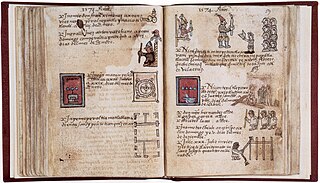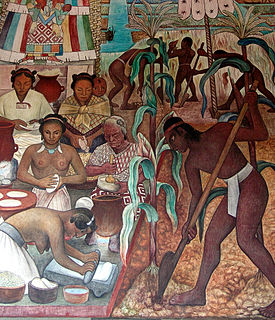Related Research Articles

Tenochtitlan, also known as Mexica-Tenochtitlan, was a large Mexica altepetl in what is now the historic center of Mexico City. The exact date of the founding of the city is unclear. The date 13 March 1325 was chosen in 1925 to celebrate the 600th anniversary of the city. The city was built on an island in what was then Lake Texcoco in the Valley of Mexico. The city was the capital of the expanding Aztec Empire in the 15th century until it was captured by the Spanish in 1521.

The Aztecs were a Mesoamerican culture that flourished in central Mexico in the post-classic period from 1300 to 1521. The Aztec peoples included different ethnic groups of central Mexico, particularly those groups who spoke the Nahuatl language and who dominated large parts of Mesoamerica from the 14th to the 16th centuries. Aztec culture was organized into city-states (altepetl), some of which joined to form alliances, political confederations, or empires. The Aztec Empire was a confederation of three city-states established in 1427: Tenochtitlan, city-state of the Mexica or Tenochca; Texcoco; and Tlacopan, previously part of the Tepanec empire, whose dominant power was Azcapotzalco. Although the term Aztecs is often narrowly restricted to the Mexica of Tenochtitlan, it is also broadly used to refer to Nahua polities or peoples of central Mexico in the prehispanic era, as well as the Spanish colonial era (1521–1821). The definitions of Aztec and Aztecs have long been the topic of scholarly discussion ever since German scientist Alexander von Humboldt established its common usage in the early nineteenth century.

Bernardino de Sahagún was a Franciscan friar, missionary priest and pioneering ethnographer who participated in the Catholic evangelization of colonial New Spain. Born in Sahagún, Spain, in 1499, he journeyed to New Spain in 1529. He learned Nahuatl and spent more than 50 years in the study of Aztec beliefs, culture and history. Though he was primarily devoted to his missionary task, his extraordinary work documenting indigenous worldview and culture has earned him the title as “the first anthropologist." He also contributed to the description of the Aztec language Nahuatl. He translated the Psalms, the Gospels, and a catechism into Nahuatl.

The Huexotzinco Codex or Huejotzingo Codex is a colonial-era Nahua pictorial manuscript, collectively known as Aztec codices. The Huexotzinco Codex is an eight-sheet document on amatl, a pre-European paper made in Mesoamerica. It is part of the testimony in a legal case against members of the First Audiencia in Mexico, particularly its president, Nuño de Guzmán, ten years after the Spanish conquest in 1521. Huexotzinco, (Way-hoat-ZINC-o) is a town southeast of Mexico City, in the state of Puebla. In 1521, the Nahua Indian people of the town were the allies of the Spanish conqueror Hernán Cortés, and together they confronted their enemies to overcome Moctezuma, leader of the Aztec Empire. Cortés's indigenous allies from Tlaxcala were more successful than those Huejotzinco in translating that alliance into privileges in the colonial era and the Huejotzincan's petitioned the crown for such privileges. A 1560 petition to the crown in Nahuatl outlines their participation.
The Anales de Tlatelolco is a codex manuscript written in Nahuatl, using Latin characters, by anonymous Aztec authors. The text has no pictorial content. Although there is an assertion that the text was a copy of one written in 1528 in Tlatelolco, only seven years after the fall of the Aztec Empire, James Lockhart argues that there is no evidence for this early date of composition, based on internal evidence of the text. However, he supports the contention that this is an authentic conquest account, arguing that it was composed about 20 years after the conquest in the 1540s, and contemporaneous with the Cuernavaca censuses. Unlike the Florentine Codex and its account of the conquest of Mexico, the Annals of Tlatelolco remained in indigenous hands, providing authentic insight into the thoughts and outlook of the newly conquered Nahuas.

Aztec codices are books written by pre-Columbian and colonial-era Nahuas in pictorial and/or alphabetic form.

The Florentine Codex is a 16th-century ethnographic research study in Mesoamerica by the Spanish Franciscan friar Bernardino de Sahagún. Sahagún originally titled it: La Historia Universal de las Cosas de Nueva España. After a translation mistake, it was given the name Historia general de las Cosas de Nueva España. The best-preserved manuscript is commonly referred to as the Florentine Codex, as the codex is held in the Laurentian Library of Florence, Italy.

The Aubin Codex is a textual and pictorial history of the Aztecs from their departure from Aztlán through the Spanish conquest to the early Spanish colonial period from 1519-1521, ending in 1608. Consisting of 81 leaves, the codex is written in alphabetic Nahuatl, the language of the Aztec empire, on European paper.

Codex Osuna is an Aztec codex on European paper, with indigenous pictorials and alphabetic Nahuatl text from 1565. It has seven parts, with most being economic in content, particularly tribute, with one part having historical content. It was named after the Spanish nobleman, Mariano Francisco de Borja José Justo Téllez-Girón y Beaufort-Spontin, twelfth Duke of Osuna, in whose library the codex was held until his death in 1882. It then became part of the collection of the Biblioteca Nacional in Madrid. It is part of a lawsuit by the indigenous of a Nahua community against Spaniards, and a fragment of a much larger Mexican text; the first numbered folio in the facsimile is 464.
Domingo Francisco de San Antón Muñón Chimalpahin Quauhtlehuanitzin, usually referred to simply as Chimalpahin or Chimalpain, was a Nahua annalist from Chalco. His Nahuatl names mean "Runs Swiftly with a Shield" and "Rising Eagle", respectively, and he claimed descent from the lords of Tenango-Amecameca-Chalco.

The traditions of indigenous Mesoamerican literature extend back to the oldest-attested forms of early writing in the Mesoamerican region, which date from around the mid-1st millennium BCE. Many of the pre-Columbian cultures of Mesoamerica are known to have been literate societies, who produced a number of Mesoamerican writing systems of varying degrees of complexity and completeness. Mesoamerican writing systems arose independently from other writing systems in the world, and their development represents one of the very few such origins in the history of writing. The conquistadors brought their distinctive cultural creations, in the form of books, from Europe to the New World which further influenced native literature.

The Codex Fejérváry-Mayer is an Aztec Codex of central Mexico. It is one of the rare pre-Hispanic manuscripts that have survived the Spanish conquest of Mexico. As a typical calendar codex tonalamatl dealing with the sacred Aztec calendar – the tonalpohualli – it is placed in the Borgia Group. It is a divinatory almanac in 17 sections. Its elaboration is typically pre-Columbian: it is made on deerskin parchment folded accordion-style into 23 pages. It measures 16.2 centimetres by 17.2 centimetres and is 3.85 metres long.

The Codex Kingsborough, also known as the Codex Tepetlaoztoc, is a 16th-century Mesoamerican pictorial manuscript, detailing the history of Tepetlaoztoc and the abuse of the encomenderos who took control after the Spanish conquest of Mexico. It is currently in the collections of the British Museum.

The Borgia Group is the scholarly designation of number of mostly pre-Columbian documents from central Mexico. In 1830–1831, they were first published in their entirety as colored lithographs of copies made by an Italian artist, Agustino Aglio, in volumes 2 and 3 of Lord Kingsborough's monumental work titled Antiquities of Mexico. They were named the “Codex Borgia Group” by Eduard Seler, who in 1887 began publishing a series of important elucidations of their contents.

The Codex Azcatitlan is an Aztec codex detailing the history of the Mexica and their migration journey from Aztlán to the Spanish conquest of Mexico. The exact date when the codex was produced is unknown, but scholars speculate it was crafted some time between the mid-16th and 17th centuries. The name of this important Mexica pictorial manuscript was suggested by its first editor, Robert H. Barlow, who erroneously interpreted the anthill on page 2 as the glyph for “Aztlán.” In the Bibliothèque nationale de France, where it is housed, it is known as Histoire mexicaine, [Manuscrit] Mexicain 59–64.

Mixtec writing originated as a logographic writing system during the Post-Classic period in Mesoamerican history. Records of genealogy, historic events, and myths are found in the pre-Columbian Mixtec codices. The arrival of Europeans in 1520 AD caused changes in form, style, and the function of the Mixtec writings. Today these codices and other Mixtec writings are used as a source of ethnographic, linguistic, and historical information for scholars, and help to preserve the identity of the Mixtec people as migration and globalization introduce new cultural influences.
Arthur James Outram Anderson was an American anthropologist specializing in Aztec culture and translator of the Nahuatl language.
New Philology generally refers to a branch of Mexican ethnohistory and philology that uses colonial-era native language texts written by Indians to construct history from the indigenous point of view. The name New Philology was coined by James Lockhart to describe work that he and his doctoral students and scholarly collaborators in history, anthropology, and linguistics had pursued since the mid-1970s. Lockhart published a great many essays elaborating on the concept and content of the New Philology and Matthew Restall published a description of it in the Latin American Research Review. The techniques of the New Philology have also been applied in other disciplines such as European medieval studies.

Tlatelolco was a prehispanic altepetl or city-state, in the Valley of Mexico. Its inhabitants were known as Tlatelolca. The Tlatelolca were a part of the Mexica, a Nahuatl-speaking people who arrived in what is now central Mexico in the 13th century. The Mexica settled on an island in Lake Texcoco, founding the altepetl of Mexico-Tenochtitlan on the southern portion of the island. In 1337, a group of dissident Mexica broke away from the Tenochca leadership in Tenochtitlan and founded Mexico-Tlatelolco on the northern portion of the island. Tenochtitlan was closely tied with its sister city, which was largely dependent on the market of Tlatelolco, the most important site of commerce in the area.

Various types of visual arts developed in the geographical area now known as Mexico. The development of these arts roughly follows the history of Mexico, divided into the prehispanic Mesoamerican era, the colonial period, with the period after Mexican War of Independence, the development Mexican national identity through art in the nineteenth century, and the florescence of modern Mexican art after the Mexican Revolution (1910-1920).
References
- ↑ Glass, John B. in collaboration with Donald Robertson. "A Census of Native Middle American Pictorial Manuscripts". article 23, Handbook of Middle American Indians, Guide to Ethnohistorical Sources Part 3. University of Texas Press 1975, census #344, pp. 212-13. ISBN 0-292-70154-3
- ↑ Altman, Ida. The War for Mexico's West: Indians and Spaniards in New Galicia, 1524-1550. Albuquerque: University of New Mexico Press 2010. ISBN 978-0826-34493-9
- ↑ Barbara E. Mundy, “Indigenous Dances in Early Colonial Mexico City,” in ‘’Festivals & Daily Life in the Arts of Colonial Latin America, 1492-1850: Papers from the 2012 Mayer Center Symposium at the Denver Art Museum’’, edited by Donna Pierce. Denver: Denver Art Museum 2014, pp. 20-26.